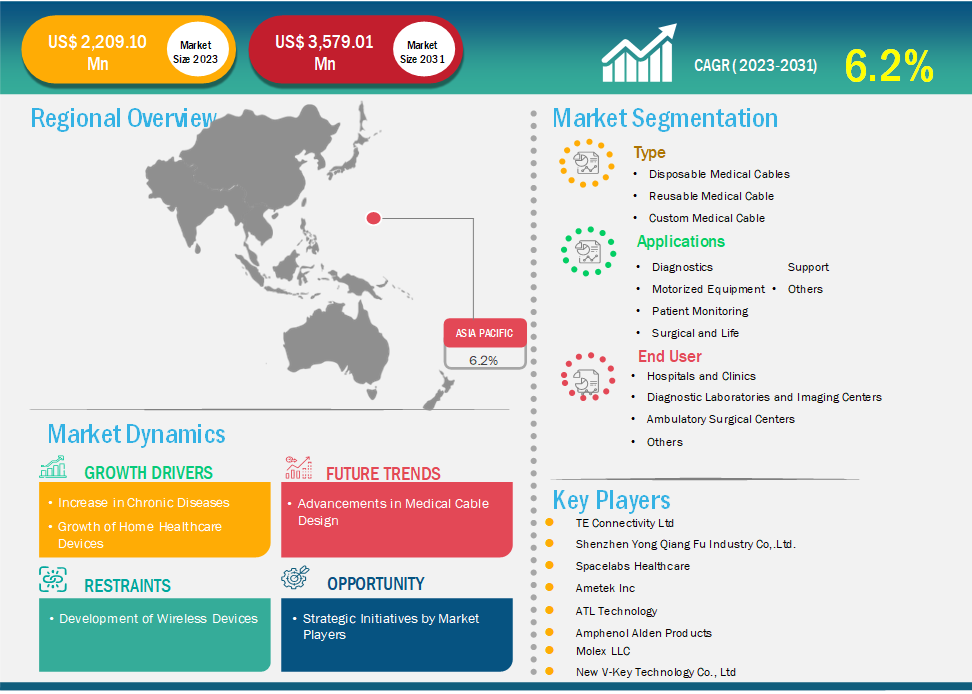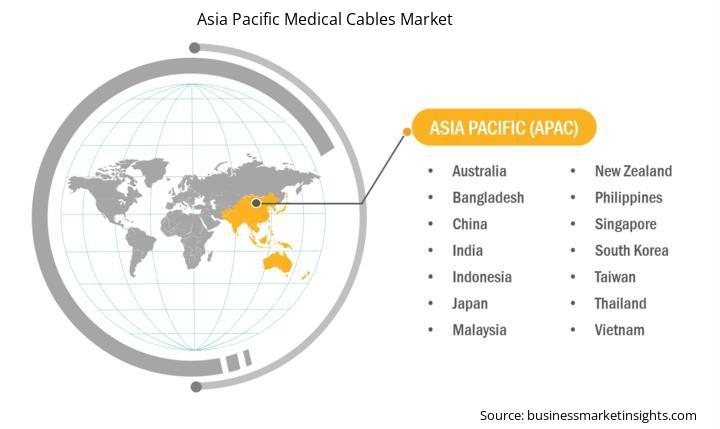Asia Pacific Medical Cables Market Report (2021-2031) by Scope, Segmentation, Dynamics, and Competitive Analysis
No. of Pages: 151 | Report Code: BMIRE00031887 | Category: Life Sciences
No. of Pages: 151 | Report Code: BMIRE00031887 | Category: Life Sciences
The Asia Pacific medical cables market size is expected to reach US$ 3,579.01 million by 2031 from US$ 2,209.10 million in 2023. The market is estimated to record a CAGR of 6.2% from 2023 to 2031.
The Asia Pacific medical cables market is experiencing significant growth due to the increasing demand for advanced medical devices and technological innovations in healthcare. The region's rising healthcare infrastructure, along with the expanding elderly population, is driving the need for medical cables in various applications such as diagnostic imaging, patient monitoring, and surgical instruments. Medical cables, including data cables, power cables, and connectivity solutions, are integral to the functionality of medical equipment. Countries like China, India, Japan, and South Korea are key contributors to the market, with increasing investments in healthcare technologies and expanding medical device manufacturing. Additionally, the growing trend of minimally invasive surgeries and the rise of telemedicine are further augmenting the demand for high-performance, durable medical cables. With these factors, the Asia Pacific medical cables market is expected to continue expanding in the coming years, presenting opportunities for manufacturers and stakeholders in the medical technology sector.

Key segments that contributed to the derivation of the medical cables market analysis are type, application, and end user.
The medical cables market in Asia Pacific is experiencing strong growth, driven by technological advancements, increasing awareness of genetic conditions, and the rising demand for personalized healthcare. Key factors contributing to this growth include the increasing prevalence of genetic disorders, advancements in genomic research, and the expansion of applications such the miniaturization of medical cable is transforming its design and performance. These advancements are resulting in the demand for heightened efficiency, versatility, and minimum invasiveness. The high-quality micro-cables provide flexibility, reliability, and enhanced performance across various medical applications. These micro-cables are used in minimally invasive surgical procedures, diagnostic imaging, and wearable health technologies owing to their lighter, thinner, and easier-to-maneuver properties. Integration of these medical devices with advanced medical cables amplifies their performance in complex signal transmission without damage to safety or functionality. These applications include surgery via robotic assistance, laparoscopic tools, and other minimally invasive procedures, which benefit from precision but much less damage to tissues surrounding the incision. They find applications in catheter-based interventions and even in endoscopic imaging systems, where compactness and flexibility are crucial for accessing the small or hard-to-reach parts of the human body.
These technical advancements, such as advanced materials and engineering solutions, create the demand for micro-cabling. The leading-edge manufacturing of micro-cable products utilizes specific biocompatible materials, including medical-grade silicone and thermoplastic elastomers, to make their products safer and more durable. Moreover, these cables have improvement in their electromagnetic shielding to maintain signal integrity in imaging technologies such as MRI and ultrasound. These include applications on wearable health devices such as smartwatches or remote patient monitoring devices, connected via Bluetooth or Wi-Fi, enabled through advanced micro-cabling solutions, giving real-time health tracking and chronic disease management.
Advanced micro-cables have enabled the miniaturization of imaging systems such as micro-endoscopes and handheld ultrasound devices for small and confined medical spaces, along with optimal imaging quality. These systems are gaining popularity in outpatient settings and point-of-care diagnostics and are expected to contribute to the medical cable market growth. Furthermore, the improvement in signal performance and flexibility encompasses the latest high-performance micro-cable that minimizes surface dimensions in comparison to its larger counterparts, highlighting the trend of miniaturization as well as high-quality micro-cables to the medical cable market. With mainstream healthcare converging toward minimal invasiveness and improved diagnostic imaging, advanced micro-cabling solutions are expected to contribute the market growth in coming years as cancer diagnosis, prenatal screening, and metabolic disorder testing. The adoption of genetic testing in clinical practice is also facilitated by government initiatives promoting personalized medicine. Leading players in the market, including Eurofins Scientific, 23andMe, and Illumina, are at the forefront of providing a wide range of testing services, contributing to the market’s development. This growth is expected to be further fueled by continuous innovation and improvements in testing accuracy and affordability.
Based on country, the Asia Pacific medical cables market comprises China, Japan, India, Australia, South Korea, and the Rest of Asia Pacific. China held the largest share in 2023.
According to the study titled “Estimated Burden of Stroke in China in 2020,” published in 2023, China recorded the incidence of stroke at 3.4 million, prevalence at 17.8 million, and mortality at 2.3 million among people aged 40 years and above in 2020. Every year, nearly 2,000,000 people experience their first stroke. Medical cables connect imaging devices, enabling rapid data transmission for diagnosis. They also link monitoring systems and therapeutic devices, ensuring real-time patient monitoring and efficient delivery of treatments crucial for effective stroke management.
The rising prevalence of chronic diseases, including cardiovascular diseases (CVDs), necessitates the use of sophisticated medical monitoring and treatment devices that depend on reliable medical cabling systems. CVD is the leading cause of healthcare burden in China. The prevalence and incidence of this disease continue to rise across the country. As per the research article titled “Cardiovascular Disease Mortality and Potential Risk Factor in China: A Multi-Dimensional Assessment by a Grey Relational Approach,” published in April 2022, CVD is one of the major healthcare concerns in the country. Medical cables facilitate connections between diagnostic equipment, ensuring accurate monitoring of heart activity. They help link therapeutic devices for administering treatments, enabling real-time data transmission that enhances patient care and management in cardiovascular disease. Additionally, according to a recent study, “Chronic Illness and Ageing in China,” published in 2020, China's population is aging, and chronic illnesses are increasingly prevalent. From 2010 to 2040, it is estimated that the proportion of people aged 60 years and above in China will rise from 12.4% (168 million) to 28% (402 million). In the country, ~80% of deaths in people aged 60 years and above are caused by chronic diseases, the most prevalent diseases being stroke, ischemic heart disease, and chronic obstructive pulmonary disease (COPD).
| Report Attribute | Details |
|---|---|
| Market size in 2023 | US$ 2,209.10 Million |
| Market Size by 2031 | US$ 3,579.01 Million |
| CAGR (2023 - 2031) | 6.2% |
| Historical Data | 2021-2022 |
| Forecast period | 2024-2031 |
| Segments Covered |
By Type
|
| Regions and Countries Covered | Asia Pacific
|
| Market leaders and key company profiles |
|
Some of the key players operating in the market include TE Connectivity Ltd; Shenzhen Yong Qiang Fu Industry Co.; Ltd; Spacelabs Healthcare; Ametek Inc; ATL Technology; Amphenol Alden Products; Molex LLC; and New V-Key Technology Co., Ltd among others. These players are adopting various strategies such as expansion, product innovation, and mergers and acquisitions to provide innovative products to their consumers and increase their market share.
The following methodology has been followed for the collection and analysis of data presented in this report:
The research process begins with comprehensive secondary research, utilizing both internal and external sources to gather qualitative and quantitative data for each market. Commonly referenced secondary research sources include, but are not limited to:
Note: All financial data included in the Company Profiles section has been standardized to USD. For companies reporting in other currencies, figures have been converted to USD using the relevant exchange rates for the corresponding year.
The Insight Partners’ conducts a significant number of primary interviews each year with industry stakeholders and experts to validate its data analysis, and gain valuable insights. These research interviews are designed to:
Primary research is conducted via email interactions and telephone interviews, encompassing various markets, categories, segments, and sub-segments across different regions. Participants typically include:

The Asia Pacific Medical Cables Market is valued at US$ 2,209.10 Million in 2023, it is projected to reach US$ 3,579.01 Million by 2031.
As per our report Asia Pacific Medical Cables Market, the market size is valued at US$ 2,209.10 Million in 2023, projecting it to reach US$ 3,579.01 Million by 2031. This translates to a CAGR of approximately 6.2% during the forecast period.
The Asia Pacific Medical Cables Market report typically cover these key segments-
The historic period, base year, and forecast period can vary slightly depending on the specific market research report. However, for the Asia Pacific Medical Cables Market report:
The Asia Pacific Medical Cables Market is populated by several key players, each contributing to its growth and innovation. Some of the major players include:
The Asia Pacific Medical Cables Market report is valuable for diverse stakeholders, including:
Essentially, anyone involved in or considering involvement in the Asia Pacific Medical Cables Market value chain can benefit from the information contained in a comprehensive market report.